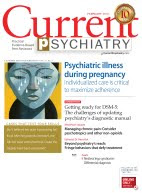Elana Harris, MD, PhD, Assistant professor, Division of child and adolescent psychiatry, Cincinnati Children’s Hospital Medical Center, Cincinnati, OH
Steve W. Wu, MD, Assistant professor, Division of child neurology, Cincinnati Children’s Hospital Medical Center, Cincinnati, OH
Tics, such as strong eye blinks or repetitive shoulder shrugs, can distress a child or his/her parents, but the conditions associated with tic disorders often are more problematic than the tic disorder itself. High rates of comorbid conditions are recognized in persons with Tourette syndrome, including:
- obsessive-compulsive disorder (OCD) in >80%
- attention-deficit/hyperactivity disorder (ADHD) in ≤70%
- anxiety disorders in 30%
- rage, aggression, learning disabilities, and autism less commonly.
The strategy we recommend for managing tic disorders includes assessing tic severity, educating the family about the illness, determining whether a comorbid condition is present, and managing these conditions appropriately. Above all, we emphasize a risk-benefit analysis guided by the Hippocratic principle of “do no harm.”
Read full text (free access)Comment on this article
Email the editor


Whilst the illustrative case of Sammy clearly went on to develop more distinctive symptoms of Tourette's, it is something not to forget that children with allergies will often experience itching or irritation of the eyelids, nostrils and throat causing them to blink,sniff, touch their nose,clear their throat, and so on. I expect that presence at times of sneezing, runny or blocked nose may help to distinguish, but there is an interesting overlap here. (Think of pruritus which also may have allergic, other dermatologic or systemic causes,but also psychological and "attentional" and compulsive aspects.)
ReplyDeleteAnother comment. I was intrigued by the authors' statement you tell the parents "you typically do not treat children with antipsychotics for more than one year continuously". Up till now I had always thought that the decision whether to continue or not at any point depended on an individualized risk/benefit approach (the severity of symptoms and the degree of relief versus unwanted effects particularly as reflected in the monitoring of weight, EPS and so on). Are they referring to Tourette's specifically or all uses including psychosis and/or mania? Could they direct me to any sources regarding the guidance that specifies a one year cutoff point?
ReplyDelete